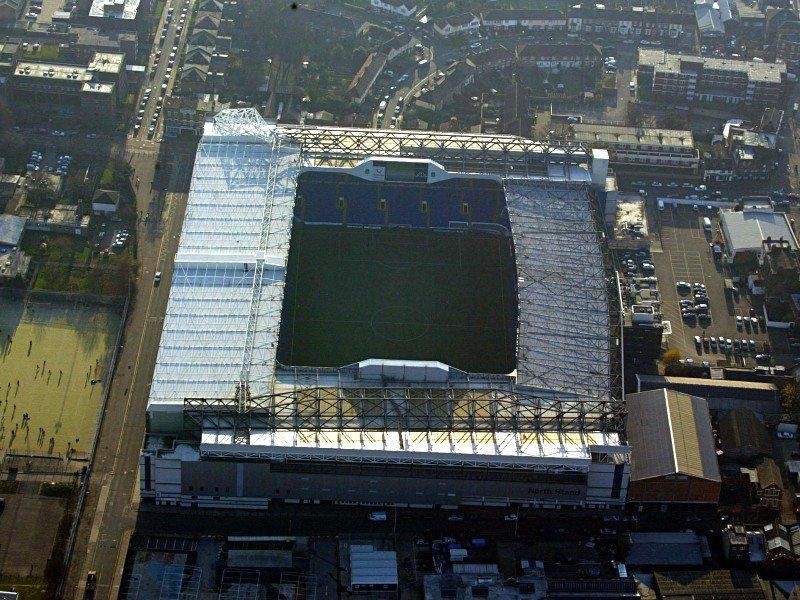Every week, hundreds of thousands of Londoners travel to watch their favourite football team play in one of the capital’s numerous stadiums. It’s one of the biggest mass movements of Londoners outside of commuting. But although there has been a lot of campaigning to encourage people to cycle to work, many football fans in the capital remain unaware of the benefits of cycling to the game and soaking up the atmosphere on two wheels. At Cycle Lifestyle we wanted to try it out, and, as life-long supporters of Spurs, there was only one club we wanted to ride to... 
Ok – I’m going to White Hart Lane today to watch live premiership football. I’ll just do a last minute check. Wallet, check. Keys, check. Phone, check. Tickets, check. Bike, check. Hang on a minute… Yep, that’s right, I said ‘bike’. It’s a concept that is perhaps new to many football supporters across the country – me included.
From the first time you go to a game as a kid you learn that watching the match and supporting your team isn’t just about seeing 90 minutes of football. It’s about much, much more. The excitement of a game starts way before kick-off. It starts in ordering your ticket, getting it through the post, and organising who’s going. It starts in studying the two teams’ form and the availability of the players, then talking about the probable starting XI and formations, and what good business the club could do this summer.
But, above all, travelling to the game is part of the excitement. It’s important to meet up beforehand with your mates, to talk about the game, settle your nerves, soak up the atmosphere and have a bit of banter with the away fans.
I usually go to Spurs in one of three ways – two buses then a walk, a cab then a walk, or a drive then a walk. It’s notoriously hard to get anywhere near the Lane by most means of transport, especially on busy match days, so there’s always a walk involved at the end.
It’s the walking section that enables me to really feel the excitement of the build-up. The stadium looms closer and the fans number more and more. The aroma of hot dogs and fried onions swirls around and pockets of fans sing songs. It’s all part of the fun – working towards the crescendo, stringing out the enjoyment of the day.
Being on the bike gave me that feeling throughout the whole journey, not just the usual walking part. We were in the elements with the tension of the game bubbling and simmering as we drew closer. Our route took us through quiet back streets as we pedalled and talked about the game. We went through a park where there were kids playing football next to a half pipe. There were BMX’s flying up and down it, but just this once I decided I wouldn’t get involved – I hadn’t brought my safety knee and elbow pads, or my sense of balance.
We rolled past rivers and streams and underneath the coughing A406. We had a laugh with fans walking to the game and ghosted past the endless queues of traffic as we got closer to the ground. We passed a handwritten sign saying “Matchday, Parking £8” and decided that we’d spend our £8 on lunch instead.
It was pretty satisfying to turn up at the Paxton End without breaking a sweat, or spending any money. Easy peasey.
 It wasn’t quite as easy to find out where the bike racks were located. We’d been told by the club that they had recently been installed, but most policemen and stewards hadn’t heard of them. One steward’s response of “Nah, we haven’t got any” made us register just how little bikes are used to get to games.
It wasn’t quite as easy to find out where the bike racks were located. We’d been told by the club that they had recently been installed, but most policemen and stewards hadn’t heard of them. One steward’s response of “Nah, we haven’t got any” made us register just how little bikes are used to get to games.
We eventually found out the racks were somewhere in the main club car park in Bill Nicholson Way. Exciting for us… but this is the main entrance for the players, Tottenham Hotspur Execs, club employees, Executive Box owners and the generally rich and famous. This wasn’t the shiny new facility encouraging hundreds of fans to cycle to games that I had been expecting. It clearly wasn’t there for your average supporter.
Or any supporter in fact. It turned out that we weren’t able to use the bike racks as they weren’t accessible. Why? They were completely hemmed in by Bentleys, 4x4s, BMWs and sports cars which were parked in front of them! We simply couldn’t get to them. I spoke to the steward (who was a lovely bloke and really apologetic). “I guess there’s more money in those guys (car drivers) than there is in you two” he said, smiling, and I guess he’s not wrong. We parked our bikes against some railings instead.
To be fair to Spurs, they’ve been proactive recently in pursuing an environmental agenda, helping to launch the new 10:10 project last year where organisations commit to cutting carbon emissions by 10% in 2010. The club has invested in lower-wattage floodlights and installed recycling points for fans to use on match days, and their matchday programmes now offer tips on being green.
And it turns out that the bike racks had been installed as a resource for staff members rather than fans, due to space restrictions in and around the current stadium. In fact, they were such a recent addition it’s understandable that it wasn’t yet common knowledge among club employees where they were (or indeed who they were for). The club’s current environmental measures are about implementing a green culture within the existing framework, but the future promises a fantastic new stadium, currently in the advanced stages of planning. Not only will this project rejuvenate the local area, it promises to include environmental sustainability as a major component.
I urge the club to make sure the new stadium incorporates ample cycling facilities for Spurs supporters as well as employees. Until then, if you are going to cycle to Spurs (an experience we wholly recommend), you’ll have to find a suitable place to park and lock-up in the surrounding public areas.
Our disappointment about the racks was tempered when we discovered that the tickets the club had provided were actually in an Executive box. Blimey, thanks! Never watched football in a box before, especially not at Spurs!
But now it was our turn to feel sheepish. Before we left for the football I was doing a bit of gardening at my cricket club’s grounds in preparation for the forthcoming season (I’m not monogamous with my sports; in fact, in the winter I even cheat on football with rugby). Ben had offered to help out for a couple of hours too.
It was, however, very muddy. So much so that an intelligent person would have brought spare clothes. A less intelligent person might have worn jeans, white socks and smart shoes then gone to a football game completely covered in mud. As it turned out, we walked through the Executive lounge surrounded by sharp-suited ex players and businessmen while Ben’s muddy footprints sketched his route over the expensive Spurs-crested carpet. Five minutes previously I had successfully persuaded him to un-tuck his jeans out of his muddy white socks and reassured him that buying some trousers from a second-hand shop wouldn’t necessarily be a better option.
With him being the editor I wonder if he’ll keep this bit in!? We’ll see.
So we had our own box and a TV which had the commentary on and we sat above the regular public in our glass room on comfy chairs. Have it.
It certainly was a once-in-a-lifetime opportunity and an amazing day. We won 2-0 and as the game went on and the muffled crowd noises ebbed and flowed, it suddenly dawned on me that I was missing being pitch-side. The game was framed by glass, so I couldn’t hear the normal cheering, chanting and inane swearing. It was a little bit stuffy, to the extent that I might as well have been watching it on TV at home.
That’s when it occurred to me that this was why I enjoyed the ride here much more. Cycling to the ground was like watching the build up to the game “live, pitch side”. Being in a car or bus is just like being in a box: not quite as cool as it looks, and probably not quite worth the money. Glancing left towards next box along, where the Donkey Lifestyle delegation were sitting glumly in their sombreros, I got the feeling we weren’t the only ones.
As we were leaving, and I was grappling with my bike lock and the fence, the club’s big iron gates were opened and I had to get out of the way of a big 4x4 carrying Jude Law and his driver… straight into a massive traffic jam. I bet he wishes he had a bicycle like mine.
Written by Gareth Jenkins.


 It wasn’t quite as easy to find out where the bike racks were located. We’d been told by the club that they had recently been installed, but most policemen and stewards hadn’t heard of them. One steward’s response of “Nah, we haven’t got any” made us register just how little bikes are used to get to games.
It wasn’t quite as easy to find out where the bike racks were located. We’d been told by the club that they had recently been installed, but most policemen and stewards hadn’t heard of them. One steward’s response of “Nah, we haven’t got any” made us register just how little bikes are used to get to games.
 as an attendant on a bicycle-hire scheme in Richmond Park. Impressed by the smiles on the faces of his customers as they returned from completing the park’s eight-mile circuit, Parker decided to try to set up a similar scheme in Hyde Park. But he soon found that this park was too small to encompass a decently long route, so he began exploring the surrounding areas – down Constitution Hill and along the Mall, where he saw a scenic side of London that’s usually hidden away behind closed Tube doors or gridlocked highstreets. Parker then turned his attentions to Victoria Park and its environs – along the canal to the Isle of Dogs and under the Greenwich footbridge. He was finding out much more than he’d bargained for.
as an attendant on a bicycle-hire scheme in Richmond Park. Impressed by the smiles on the faces of his customers as they returned from completing the park’s eight-mile circuit, Parker decided to try to set up a similar scheme in Hyde Park. But he soon found that this park was too small to encompass a decently long route, so he began exploring the surrounding areas – down Constitution Hill and along the Mall, where he saw a scenic side of London that’s usually hidden away behind closed Tube doors or gridlocked highstreets. Parker then turned his attentions to Victoria Park and its environs – along the canal to the Isle of Dogs and under the Greenwich footbridge. He was finding out much more than he’d bargained for. . Later I was struck by another parallel, between the Darwinian explanation for the evolution of the eye and Parker’s commitment to Minimum Functioning for the system of routes he has proposed: both are organs that must start out rudimentary before evolving into something more refined and wonderful.
. Later I was struck by another parallel, between the Darwinian explanation for the evolution of the eye and Parker’s commitment to Minimum Functioning for the system of routes he has proposed: both are organs that must start out rudimentary before evolving into something more refined and wonderful. In May this year, the
In May this year, the 

